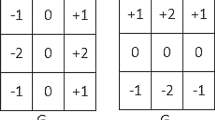Abstract
Double threshold method of traditional Canny operator detects the edge rely on the information of gradient magnitude, which has a lower edge connectivity and incomplete image information. Aiming at this problem, we proposed an edge detection algorithm based edge connection—the Hough Transform based Canny (HT-Canny) edge detection algorithm. HT-Canny algorithm guided by high threshold image, which obtains edge direction through calculating edge endpoint gradient and connects the edge by using the Hough Transform instead of traditional double threshold method. It avoids the limitation of traditional Canny algorithm, which must set the double threshold manually and protect the low intensity edge especially. The experimental results show that HT-Canny algorithm has stronger edge connectivity and can distinguish edge points and non-edge points effectively, which not only retain the advantages of the traditional Canny algorithm but also make the detection result more complete and comprehensive.
Similar content being viewed by others
References
Z. Xiaofeng, Z. Yu, and Z. Ran, “Image edge detection method of combining wavelet lift with canny operator,” Proc. Eng. 15, 1335–1339 (2011).
P. Gaur and S. Tiwari, “Recognition of 2D barcode images using edge detection and morphological operation,” Int. J. Comput. Sci. Mobile Computing 3 (4), 1277–1282 (2014).
W. Bing and F. Shaosheng, “An improved canny edge detection algorithm,” in Proc. Int. Workshop on Computer Science and Engineering (Qingdao, 2009), pp. 497–500.
C. Yu, D. Caixia, and C. Xiaxia, “An improved canny edge detection algorithm,” Int. J. Hybrid Inf. Technol. 8 (10), 359–370 (2015).
J. Canny, “A computational approach to edge detection,” Pattern Anal. Mach. Intellig. PAMI-8 (6), 679–698 (1986).
L. Chao, Z. Jiliu, and H. Kun, “Adaptive edge-detectionmethod based on canny algorithm,” Comput. Eng. Design 31 (18), 4036–4039 (2010).
Q. Danyang, J. Zheng, C. Yi, and L. Bin, “An improved edge linking algorithm for canny edge detection,” J. Wuhan Univ. Sci. Technol. 37 (4), 310–315 (2014).
W. Zhi and H. Saixian, “An adaptive edge-detection method based on canny algorithm,” in Proc. Int. Conf. on Environmental Science and Information Application Technology, ESIAT 2009 (Wuhan, July 4–5, 2009).
G. Hao, L. Min, and H. Feng, “Improved self-adaptive edge detection method based on canny,” in Proc. Int. Conf. on Intelligent Human-machine Systems and Cybernetics (Hangzhou, 2013), pp. 527–530.
H. Yuankai, W. Gen, Z. Yudong, and W. Lenan, “An adaptive threshold for the canny operator of edge detection,” in Proc. Int. Conf. on Image Analysis and Signal (Zhejiang, 2010), pp. 371–374.
P. Hough, US Patent 3069654 A (1962).
D. Dagao and X. Meng, “An improved hough transform for line detection,” in Proc. Int. Conf. on Computer Application and System Modeling (Taiyuan, 2010), pp. 354–357.
W. Liqun, G. Shuqiang, and G. Xiaoli,“Method of color image segmentation based on color constancy,” J. Northeast Electric Power Univ. 35 (1), 78–82 (2015).
L. Jing and Z. Jixian, “A new power-line extraction method based on airborne LiDAR point cloud data,” in Proc. Int. Symp. on Image and Data Fusion (Tengchong, 2011), pp. 1–4.
J. Enshu, J. Yuwei, C. Yaxue, et al., “Study on the new integrated protection of intelligent substations,” J. Northeast Electric Power Univ. 36 (6), 25–29 (2016).
L. Hui, Z. Changsheng, and S. Ning, “Edge detection based on canny operator and evaluation,” J. Heilongjiang Inst. Technol. 17 (2), 3–6 (2010).
Author information
Authors and Affiliations
Corresponding author
Additional information
The article is published in the original.
Song Renjie was born in Jilin, China, in 1963. She received the bachelor degree in electric power system and automation and master degree in computer science and technology from Northeast Electric Power University in 1985 and 1993, respectively. Now she is a professor of computer science and technology at Northeast Electric Power University. Her research interests include computer applications in power system, pattern recognition, and image processing. She has 10 papers indexed by EI.
Zhang Ziqi was born in LiaoNing, China, in 1963. She received the bachelor degree in electronic Information engineering from Shenyang University of Technology in 2014. Now she is a postgraduate of computer science and technology at Northeast Electric Power University. Her research interests include pattern recognition and image processing.
Liu Haiyang was born in JiLin, China, in 1985. He received the bachelor degree in electric power system and automation from Northeast Electric Power University in 2008 and master degree in control engineering from North China Electric Power University in 2016. Presently, Researcher at State Grid Jilin Electric Power Co., Ltd. Jilin Power Company. Scientific interests: power system analysis and control.
Rights and permissions
About this article
Cite this article
Song, R., Zhang, Z. & Liu, H. Edge connection based Canny edge detection algorithm. Pattern Recognit. Image Anal. 27, 740–747 (2017). https://doi.org/10.1134/S1054661817040162
Received:
Published:
Issue Date:
DOI: https://doi.org/10.1134/S1054661817040162




